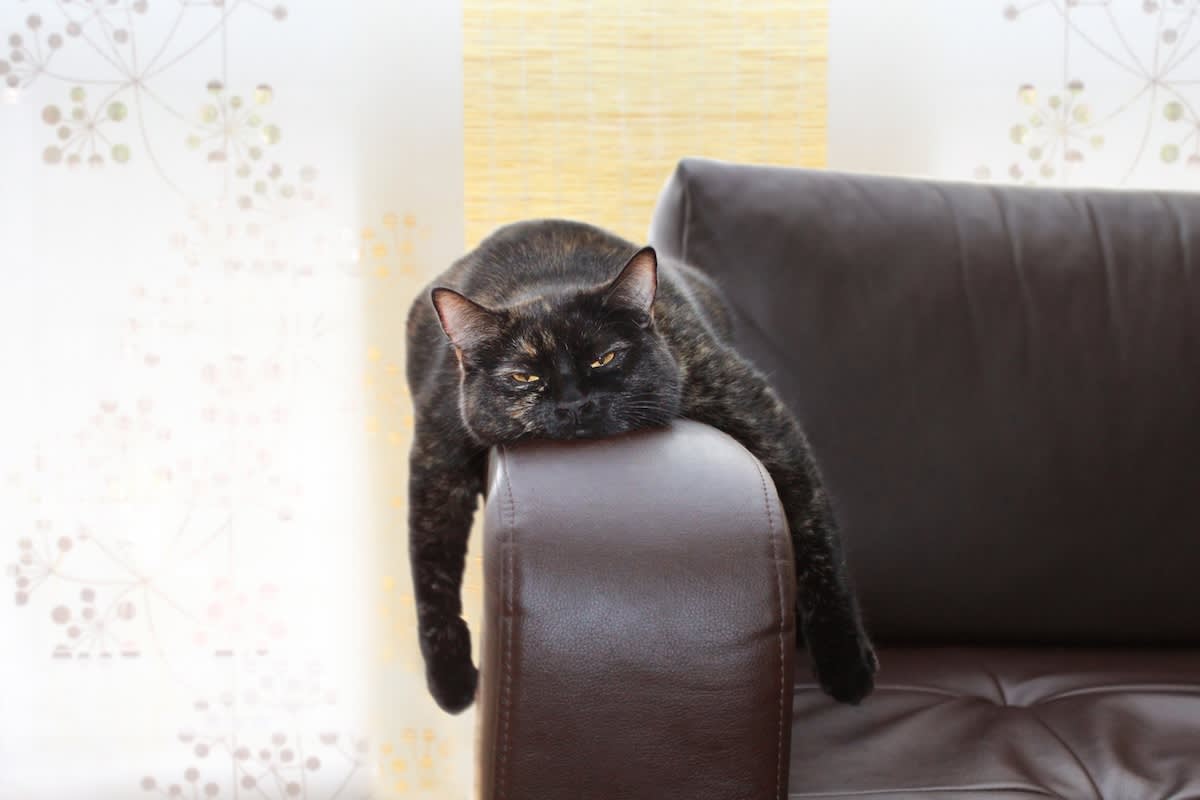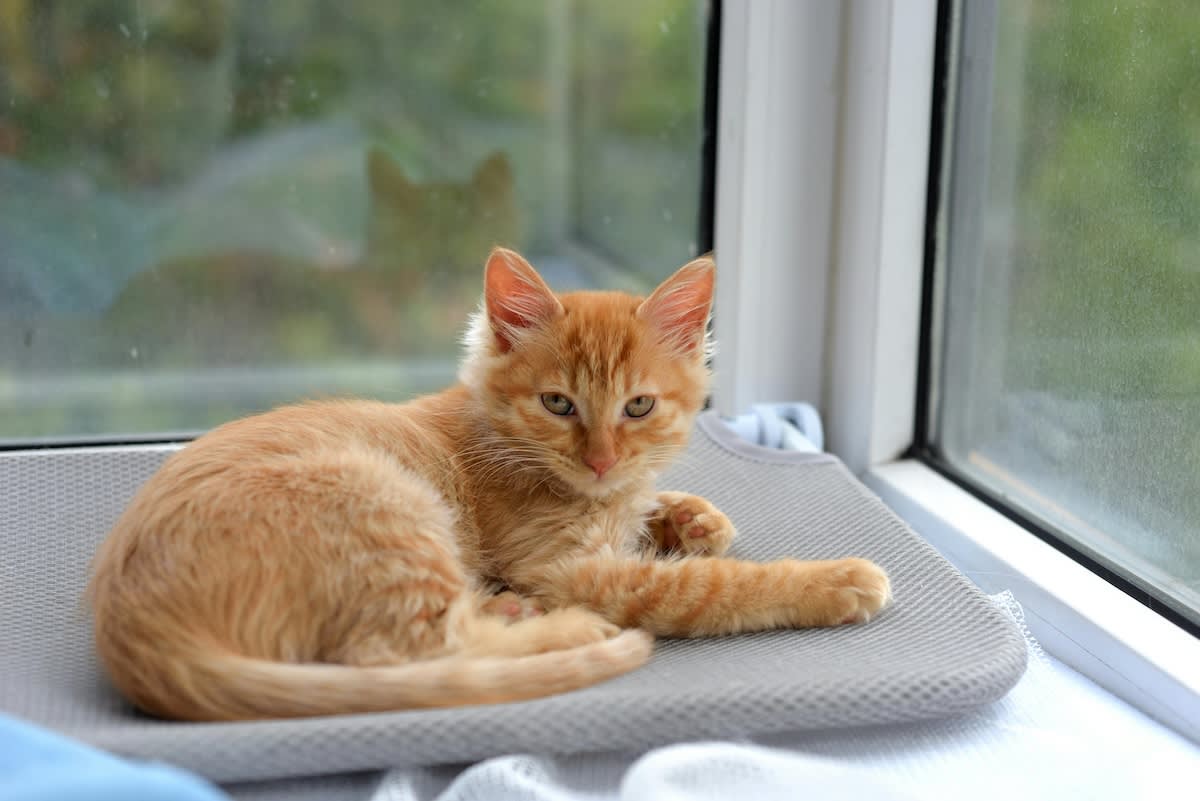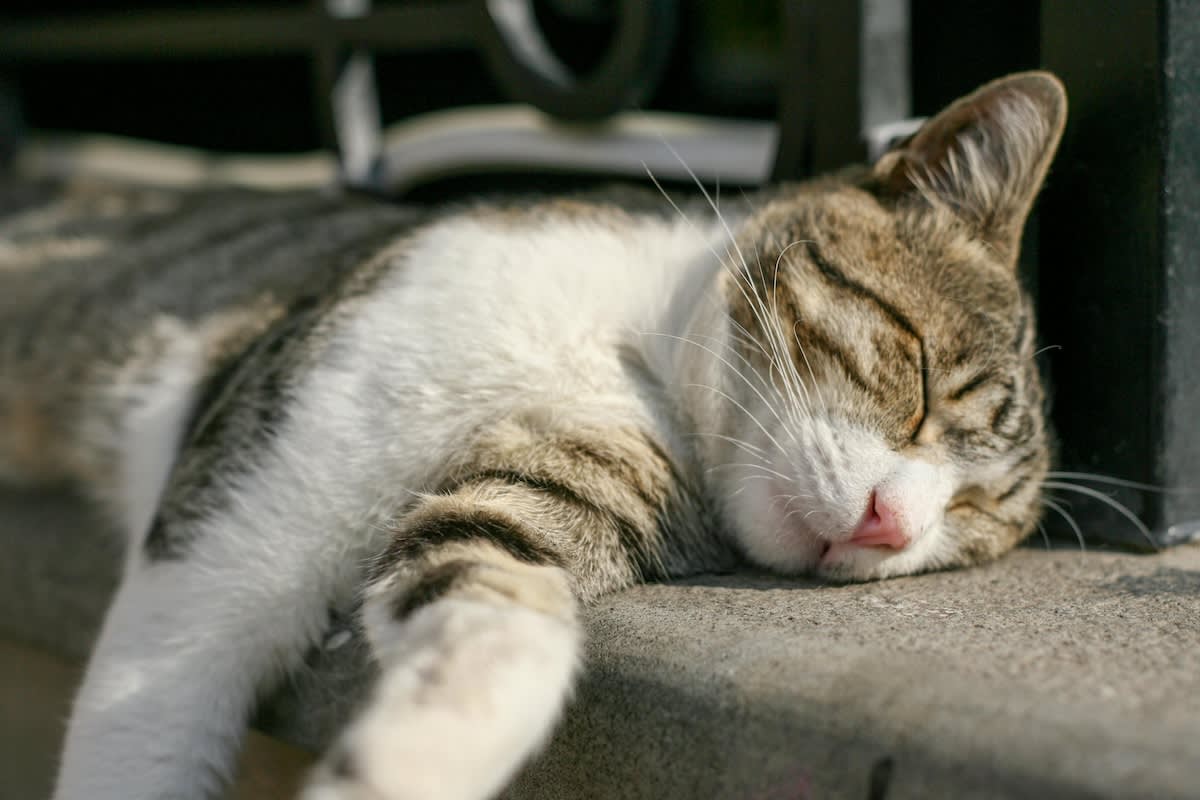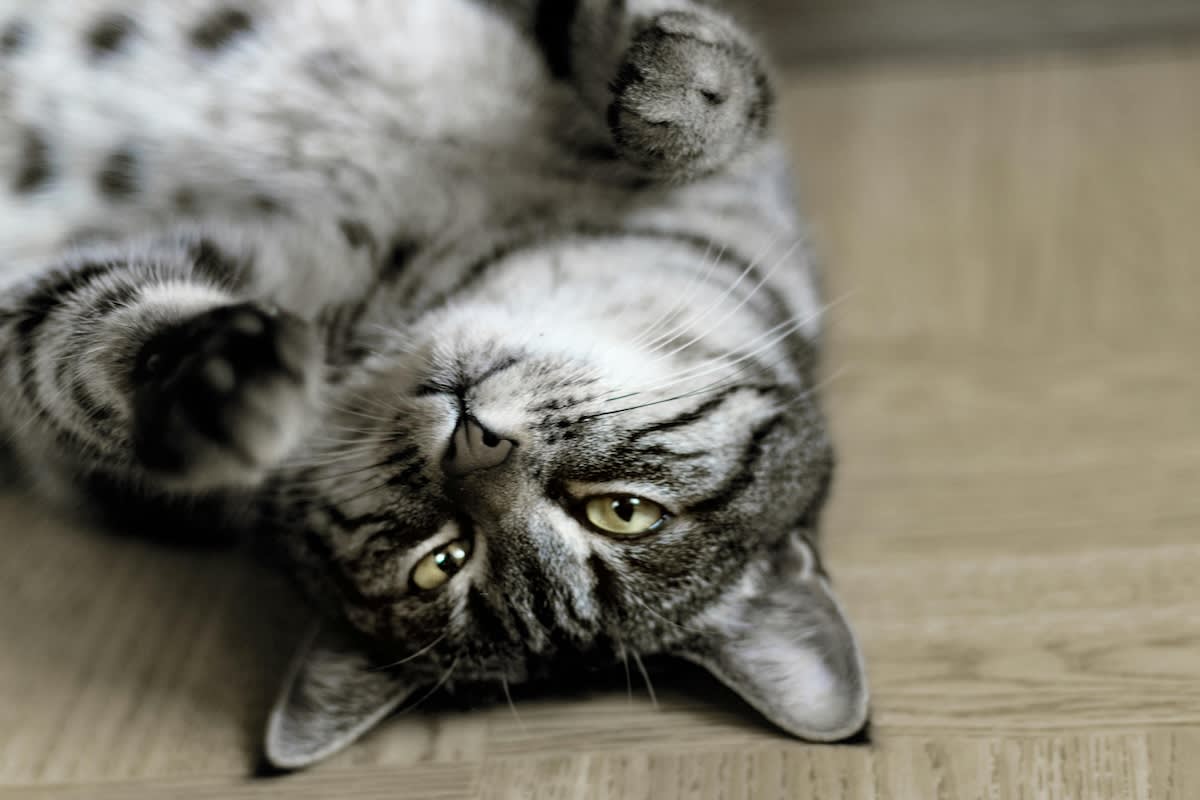
Share Article
In this article:
Bored or relaxed? Signs of relaxation Signs of boredom Boredom in indoor cats Preventing boredom in cats When to get vet help
As a cat pet parent (or ‘roommate’ or ‘in-house butler’) you’ll already know that your cat likes to sleep a lot. In fact, you might already know cats sleep for between 12 and 16 hours a day – an enviable schedule we could only dream of. So it can be tempting to shrug off your cat’s long stretches of quiet lounging as proof they’re ‘just chill’ and ‘being a cat’. But distinguishing between relaxation and boredom isn’t just semantics – it can mean the difference between a healthy, content feline and one slipping into stress, weight gain or destructive behaviour.
The difference between ‘bored’ and ‘relaxed’
When cats lack mental or physical stimulation, boredom can become an insidious stressor. Without outlets for their instincts – stalking, pouncing, exploring – they may resort to attention-seeking antics (think scratching furniture or meowing nonstop), over grooming or even pacing. Behaviourists noteopens in new tab that boredom can lead to serious issues, including obesity and anxiety-related patterns, especially for indoor catsopens in new tab with fewer outlets for activity.
On the other hand, a relaxed cat signals a state of well-being: calm breathing, loose posture, slow blinking and soft body language. These signs reflect mental safety and physical comfortopens in new tab – the kinds of subtle cues that tell you your cat is in the zone emotionally and physiologically.
Why does this distinction truly matter? Because your cat’s long-term health, your relationship with them and your home’s sanity depend on it. Stress from boredomopens in new tab can trigger a cascade of effects – poor coat condition, urinary problems, repeated behavioural issues or even aggression. Sustainable well-being, however, nurtures trust, prevents destructive episodes and supports a balanced appetite and metabolism.
In short: you want more than just a cat that ‘looks relaxed’. You want a cat that feels relaxed – which means keeping them engaged and content without stressing yourself out in the process.
Signs your cat is relaxed
Relaxation in cats can be surprisingly easy to miss or misinterpret if you don’t know what to look for. While some behaviours are unmistakable (hello, upside-down belly flop), others are more subtle but just as meaningful. Here’s how to decode your cat’s body language and behaviour to spot genuine chill vibes.
Common relaxed body language (loaf position, slow blinking, stretched out)
A relaxed cat often adopts the classic ‘loaf’ position – paws tucked neatly beneath their body, eyes half-closed – which signals they feel safe enough to rest without needing to spring into action. If your cat stretches out fully on their side or back, exposing their tummy, that’s an even stronger sign of trust and comfort. Look out for slow blinking too, often referred to as a ‘cat kiss’ – their way of saying ‘I’m content and I trust you’.
Their tail offers clues as well: a gently swishing or still tail with soft edges (not puffed or twitching) indicates ease. Ears are usually forwards or relaxed to the side, and whiskers rest loosely, not pinned back.
Behaviour patterns that show contentment
Beyond posture, relaxed cats display predictable, low-stress routines – steady eating, regular grooming, playful bursts followed by restful naps. They may seek gentle interaction on their terms, curling up near you or softly purring when stroked. Some will calmly shadow you from room to room.
These signs, especially in combination, show that your cat isn’t just existing – they’re thriving in a safe, happy environment.
Signs your cat may be bored
If you’ve ever looked over at your cat and watched them do a big deep sigh and then fall back asleep, you might have wondered if they’re bored and exasperated. But while cats may have a reputation for being low-maintenance and snoozing the day away, beneath that cool exterior is a curious, intelligent creature that thrives on stimulation. So yes, most of the time they may just be having the ultimate cat nap, but it’s the times when they’re fully awake that you need to ensure they are getting enough stimulation.
When that’s lacking, boredom can creep in. And unlike us doomscrolling on our phones, a bored cat finds other outlets to express this – often ones you won’t appreciate. Here are some key behavioural red flags.
Over-grooming or pacing
If your cat is grooming themselves excessively to the point of bald patches, irritated skin or repeated licking in one area, it may be more than normal feline hygiene preferences. Over grooming can be a displacement behaviouropens in new tab – a way to self-soothe when they’re under-stimulated, anxious or frustrated. Similarly, pacing or restless wandering around the house (especially along the same routes) can indicate that your cat is seeking something to do. This is often seen in indoor catsopens in new tab who don’t have enough opportunities to explore, climb or hunt.
Attention-seeking or destructive behaviour
A bored cat will often find ways to get your attention – whether you like it or not. Loud vocalising, pawing at you constantly, knocking objects off the table or scratching furniture despite having posts available can all be signs that they’re craving interactionopens in new tab. This isn’t naughtiness for the sake of it but your cat’s way of communicating their needs. They’re quite literally telling you, “I need more to do.” Destructive behaviour can also extend to chewing cables (extremely dangerous), unravelling toilet rolls or turning your curtains into a climbing wall.
Excessive sleeping vs healthy rest
Yes, cats sleep a lot but there’s a difference between healthy rest and boredom-induced lethargy. A relaxed, content cat will have a balance of naps, playtime, exploration and social interaction. A bored cat, by contrast, may sleep out of sheer lack of stimulation, with fewer bursts of activity and a dullness to their routine. If their sleep seems to replace play or social time, or they’re no longer responding enthusiastically to activities they once enjoyed, boredom (or a health issue) could be at play.
Recognising these signs early means you can make simple changes before boredom snowballs into stress or destructive habits.
Indoor cats and boredom
While 67 percent of UK catsopens in new tab live a hybrid indoor/outdoor life, those felines who remain indoors – whether for safety, environmental concerns or simply because their humans live in urban flats – can be more likely to suffer from lack of stimulationopens in new tab.
Unlike their outdoor counterparts, indoor cats don’t have access to the natural variety of life that keeps feline brains busy: new scents, changing weather, insects to stalk, trees to climb and fences to patrol. Without these daily mini-adventures, indoor cats can find themselves under-stimulated, especially if they’re left alone for long periods during the working day.
The risks of leaving an indoor cat unstimulated go beyond a bit of sulking. Boredom can lead to weight gainopens in new tab, as cats may graze on food to pass the time rather than because they’re hungry. Behaviourally, it can cause stress, over grooming, destructive scratching or aggression, especially in multi-cat households where space is sharedopens in new tab. Long-term, chronic boredom may even affect their physical health – stress has been linked to urinary tract issuesopens in new tab and a weakened immune response.
The good news? With thoughtful enrichment, indoor cats can live their best full, contented lives.
How to prevent boredom in cats
The good news is that preventing boredom in cats doesn’t have to be complicated, expensive or require you to stage a nightly cabaret performance for them. A little creativity, a few well-chosen toys and a willingness to mix things up can make a huge difference to your cat’s daily life. Think of it as building them a tiny adventure park – minus the admission fee.
Simple enrichment ideas
Cats are natural hunters, climbers and explorers, so providing opportunities to mimic these behaviours indoorsopens in new tab is key. Interactive toys, like feather wands or laser pointers, can help them burn off energy and satisfy their prey drive. Rotate toys regularly so they stay novel – a toy that’s been out for weeks may as well be invisible.
Puzzle feeders are another brilliant option. By making cats ‘work’ for their food, you can slow down mealtimes, engage their brains and help prevent weight gain. From simple treat balls to more elaborate puzzle trays, these mimic the problem-solving challenges cats would encounter while hunting.
Don’t underestimate the power of vertical space, either. Cats love being up high, so adding shelves, climbing trees or even a strategically placed bookcase can give them a new perspective. Window perches are a great idea, too, allowing them to live out their neighbourhood watch dreams. And of course, sometimes a cat’s favourite toy is the most inexpensive option – think cardboard boxes.
Experience the outdoors safely
For cat parents lucky enough to have a garden, catios (enclosed outdoor patios for cats) are a fantastic way to offer outdoor stimulation safely. Whether it’s a full walk-in structure or a simple tunnel system, a catio allows your cat to feel the breeze and sniff the air without the risks of traffic, disease or territorial spats. Many UK companies offer modular catio kits that work even in small terraced gardens.
If a catio isn’t possible, window boxes planted with cat-safe herbs, bird feeders outside windows (for ‘cat TV’), or supervised harness walks in secure spaces can bring the outdoors in. For indoor-only homes, rearranging furniture occasionally, hiding treats around the flat, or setting up different zones can keep things fresh and engaging.
Enrichment isn’t just about toys – it’s about giving your cat a life full of variety, choice and stimulation, so boredom doesn’t stand a chance.
When to seek veterinary advice
While a bit of mischief or a lazy afternoon nap is perfectly normal, sudden or persistent changes in your cat’s behaviour can signal that something more serious is going on. Knowing when to call in the professionals can make all the difference to your cat’s well-being.
If your cat’s boredom-related behaviours escalate, it’s worth booking a check-up with your vet. Sometimes what looks like boredom can actually be a sign of underlying stress or medical problemsopens in new tab, such as skin conditions, pain or anxiety.
Likewise, changes in appetite, litter tray habits or energy levels can point to health issues rather than personality quirks. A cat that suddenly starts sleeping much more than usual, for example, could be signalling anything from arthritis to thyroid problems. And if a once-affectionate cat becomes withdrawn or unusually clingy, that’s often a red flag, too.
Your vet can rule out medical causes first and, if needed, refer you to a qualified feline behaviourist to help address any stress or boredom issues in a structured way. Trust your instincts – you know your cat better than anyone so if something feels ‘off’, it’s always better to check. Cats are experts at hiding discomfort, so early intervention can prevent bigger problems down the line.
Resources
Cats Protection. “Indoor and Outdoor Cats Essential Guide 12opens in new tab”. www.cats.org.uk/media/1023/eg12_indoor_and_outdoor_cats.pdf.
NI Direct Government Services. “Welfare of Cats: Normal Behaviour Patterns | Nidirect.opens in new tab” nidirect.gov.uk, 20 Nov. 2015.
Henning, Julia, et al. “Cats Just Want to Have Fun: Associations between Play and Welfare in Domestic Catsopens in new tab.” Animal Welfare, vol. 32, 2023, p. e9, https://doi.org/10.1017/awf.2023.2.
PDSA. “Cats – PDSA Animal Wellbeing Report 2024.opens in new tab” pdsa.org.uk, 2024.
Heath, Sarah. “Common Feline Problem Behaviours: Unacceptable Indoor Elimination.” Journal of Feline Medicine and Surgery, vol. 21, no. 3, Feb. 2019, pp. 199–208, https://doi.org/10.1177/1098612x19831202opens in new tab.
Foreman-Worsley, R. et al. “Indoors or Outdoors? An International Exploration of Owner Demographics and Decision Making Associated with Lifestyle of Pet Cats.opens in new tab” Animals, vol. 11, no. 2, Jan. 2021, p. 253, https://doi.org/10.3390/ani11020253.
Foreman-Worsley, R. Investigation into the Behaviour and Welfare of Indoor-Housed Cats (Felis Catus)opens in new tab. June 2022, irep.ntu.ac.uk/id/eprint/49297/1/Rachel%20Foreman-Worsley%202023.pdf. Accessed 20 Oct. 2025.
Foreman-Worsley, Rachel, and Mark J. Farnworth. “A Systematic Review of Social and Environmental Factors and Their Implications for Indoor Cat Welfareopens in new tab.” Applied Animal Behaviour Science, vol. 220, Aug. 2019, p. 104841, https://doi.org/10.1016/j.applanim.2019.104841.
Bradshaw, John. “Normal Feline Behaviour… and Why Problem Behaviours Developopens in new tab.” Journal of Feline Medicine and Surgery, vol. 20, no. 5, Apr. 2018, pp. 411–21, https://doi.org/10.1177/1098612x18771203.
Amat, Marta. “Stress in Owned Cats: Behavioural Changes and Welfare Implicationsopens in new tab.” Journal of Feline Medicine and Surgery, vol. 18, no. 8, June 2015, pp. 577–86, https://doi.org/10.1177/1098612x15590867.
Zawacki, Andrea. “Study Says Pet Obesity Is Often a Product of ‘Emotional Overeatingopens in new tab.’” Carrington College, 19 Dec. 2013, carrington.edu/blog/study-says-pet-obesity-often-product-emotional-overeating/.
“Is My Cat Bored? | Blogopens in new tab.” Cats Protection, 16 Feb. 2023, www.cats.org.uk/cats-blog/cat-boredom-busters.
Ro Elfberg
Ro is Kinship UK’s Senior Editor. She has previously written and copy-edited for British Vogue, Glamour and DICE. When she’s not being manipulated into dishing out Dreamies to Kobe the cat, she spends her free time trying to convince her snake, Butters, to wear a tiny hat.



